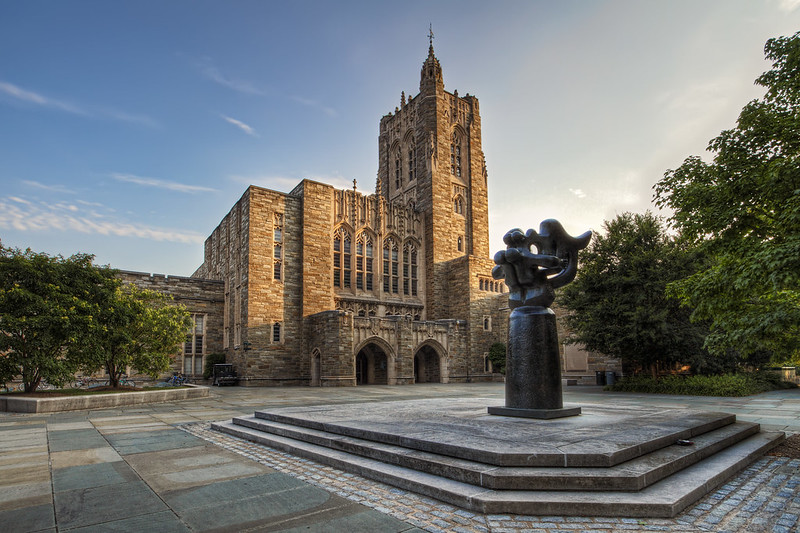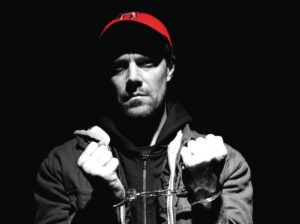American Higher Education Is Even More Corrupt Than It Looks
A new report from ProPublica and New York Magazine reveals how one billionaire parent completely gamed the college application process. Firestone Library at Princeton University. (Kah-Wai Lin / Flickr)
Firestone Library at Princeton University. (Kah-Wai Lin / Flickr)
This story is a collaboration between ProPublica and New York magazine.
The unhappy heroine of “The Mistakes Madeline Made,” which premiered Off Broadway in 2006, hates working as one of 15 personal assistants to a financier and his family. The patriarch, she observes, “runs his home the way he runs his hedge fund — using a model to protect his family against the possibility of loss or waste or even just the unexpected.” His “Household System” demands perfection: Even the hunt for a duplicate pair of New Balance sneakers is to be executed with the logistical finesse of a Navy SEAL strike.
The play was written by Elizabeth Meriwether, who would go on to create the sitcom “New Girl” for Fox. Her fictionalized account of her brief stint working for the Wall Street billionaire David E. Shaw never reached a wide audience, but the script became samizdat among the harried members of Shaw staff — as the family’s highly compensated, Ivy-educated, hierarchical cadre is known. Her disgruntled protagonist’s job making sure “nothing bad can ever happen to this family” has felt familiar to some of Meriwether’s successors.
The 68-year-old Shaw made his estimated $7.3 billion fortune by bringing the computing revolution to finance. D.E. Shaw & Co., the legendary hedge fund that bears his name, pairs proprietary trading algorithms with obsessive risk management. Less well publicized, however, are the various ways in which Shaw has applied his fund’s risk-averse, quantitative approach to nearly every aspect of his life. Employees tell stories about Shaw wanting Chinese food or a comfortable mattress, and Shaw staff exhaustively researching and testing the options in advance. It was company lore that before Shaw traveled, an assistant would take the exact same trip — same car service, same airport, same seat on the plane — to eliminate any inefficiencies. Shaw has been said to purchase tickets for several different flights on the same day in case his plans change.
He has even devised a model to protect his family from the possibility of loss or disappointment (what some might call the stuff of life itself) in that most uncertain of contemporary futures markets — namely, the college-admissions process. Like other couples of ample means, Shaw and his wife, financial journalist Beth Kobliner, have sent their three children to an elite prep school, supported them with hyperqualified nannies and tutors, and encouraged their extracurricular interests. But while the typical snowplow parent quietly eliminates potential obstacles by clearing the road ahead, Shaw and Kobliner have seemingly bulldozed an entire mountain. Even though their children were by all accounts excellent students, the Shaws pursued a remarkably elaborate and expensive pattern of philanthropy to seven of the most renowned universities in the country.
Starting in 2011, when the oldest of their three children was about two years away from applying to college, the Shaw Family Endowment Fund donated $1 million annually to Harvard, Yale, Princeton and Stanford and at least $500,000 each to Columbia and Brown. The pattern persisted through 2017, the most recent year for which public filings are available, with a bump in giving to Columbia to $1 million a year in 2016 and 2017. The foundation, which lists Kobliner as president and Shaw as treasurer and secretary, has also contributed $200,000 annually to the Massachusetts Institute of Technology since 2013.
The total donations for “general” purposes across seven years and seven elite schools are $37.3 million, which represents 62% of the foundation’s giving over that period. At minimum, experts in higher-education fundraising say, Shaw and Kobliner’s strategy improved their children’s chances of getting into at least one of the country’s top universities. At best, it would allow them to choose whichever blue-chip school they preferred, making selecting a college as easy as ordering from a takeout menu.
Most American tycoons who sweeten their children’s admissions prospects rely on a major donation to a single college, often their alma mater. And yet, from a hedge funder’s perspective, investing in multiple colleges is a classic asymmetric bet — one with minimal risk and massive potential upside. “For someone of his mentality, making a portfolio bet would make a lot of sense,” said one former Ivy League development officer. “I can tell you that within the hedge-fund community and private-equity community, this wouldn’t be unusual. It’s common for people to be giving to two or three or four schools.” (Just how many of these donations are made is hard to know because, while those from foundations like the Shaws’ are typically publicly reported, gifts from individuals are not.)
As Parke Muth, an independent counselor and former associate dean of admissions at the University of Virginia, explained, the very wealthy “are accustomed to diversifying their investments, and they apply that same philosophy to their kids’ choices.”
For his own college education, David Shaw, who grew up in Los Angeles, went to the University of California, San Diego, where he studied math, physics and information science. In 1973, he entered Stanford’s Ph.D. program in computer science. After earning his doctorate, he got a job teaching at Columbia. One former colleague remembers that Shaw arrived in New York driving a Ferrari and had his own public-relations representative, which was unusual for a faculty member. Profiles of Shaw over the years have reported that he left Columbia because Morgan Stanley & Co. made him an offer that was too good to refuse, but that may have been only part of the equation. He was also in his up-or-out year at Columbia, and his promising research project on an experimental supercomputer was perceived to have run into difficulties. “I don’t believe he was going to get tenure,” said Stephen Unger, emeritus professor of computer science. “His clock was running out.” (Through a spokesperson, the Shaw family declined to be interviewed for this story.)
At Morgan Stanley, Shaw realized that computers could do far more than simply help humans gain a financial edge; if programmed correctly, they could replace our faulty intuitions entirely. In 1988, he left Morgan Stanley to found D.E. Shaw & Co., which he conceived of as a research firm that happened to study the intersection of computing and finance. The company’s proprietary algorithms scoured markets across the world for tiny price anomalies. Shaw “pursued numerical precision with a zealous intensity,” Sebastian Mallaby writes in his 2010 book on hedge-fund giants, “More Money Than God.” “It was no good telling him that a programming task might take three to eight weeks; you had to say that it would take 5.25 but with an error of two weeks.”
The conventional wisdom in the hedge-fund world is to bet big. DESCO, as Shaw’s firm is known internally, did things differently. Its philosophy, explained one former trader at the firm, is to “bet small and bet many, many times.” Traders are advised never to make a bet that could cripple the firm. “They definitely practice what I would call extreme diversification,” the trader added. “It permeates the culture.”
To fill its storied ranks, D.E. Shaw & Co. depended on the same criteria elite colleges use in their own admissions processes. No matter one’s age or status, every applicant — from secretarial workers to traders lured from top mathematics and physics departments — had to submit their SAT scores. “It was incredibly insulting to recruit professors from MIT and ask them for their SAT scores and high school GPA,” a recruiter recalls. “They would be like, ‘I’m a tenured professor, why are you asking?’” When former Treasury secretary and Harvard president Lawrence Summers applied for a job at the firm in 2006, he was required to solve brainteasers.
Housed in a glass skyscraper near Times Square, D.E. Shaw & Co. ranks as one of the five highest-grossing hedge funds of all time. The company employs around 1,200 people, including 87 Ph.D.s and 25 International Math Olympiad medalists. At one point in the aughts, of the five employees in the D.E. Shaw mailroom, three had degrees from Columbia and one was a concert pianist from Carnegie Mellon, according to a former worker. Among its alums are John Overdeck and David Siegel, who left to form their own legendary quant firm, Two Sigma, as well as Jeff Bezos and his ex-wife, MacKenzie Tuttle. Eric Schmidt, the former Google chairman, owns a 20% stake in the firm, which he has said “feels like Silicon Valley in Manhattan.” Shaw owns almost all of the rest.
Although Shaw left the day-to-day management of the hedge fund nearly two decades ago, he’s still the chairman, and it remains molded in his image: decidedly elitist, tight-lipped and risk-averse. The firm has always operated in stealth mode, keen to protect its secret formulas. “Shaw mostly prohibited us from talking to colleagues in other groups — or sometimes even our own office mates — about what we were doing,” Cathy O’Neil, who worked at DESCO as a quant from 2007 to 2009, wrote in her 2016 book, “Weapons of Math Destruction.” (As soon as most applicants arrived at their first interview, they signed nondisclosure agreements. If hired, they signed more, which may be why former employees spoke with us anonymously.)
This secrecy and vigilance extended to the company’s extreme caution on legal and compliance issues. One of Shaw’s common sayings, repeated at an annual training session by a compliance officer, was that it was important to avoid risks and legal trouble because Shaw wanted to make sure that his kids could go to college. “He used to say that semifacetiously, as a way of saying, ‘I’m depending on this firm for my future income,’” one former employee recalled. The management of the Shaw family’s foundation reflects this prudence. At the end of 2017, more than 90% of its investments were in short-term Treasury bills.
Shaw left the hedge fund in 2001 to found D.E. Shaw Research, which applied computer simulations to the arduous process of drug development. At both places, former employees said Shaw cared about saving time almost as much as he cared about minimizing risk. “The one thing you can’t get back is his time,” a former employee who worked at the hedge fund recalled. “So you spend as much of your time to get him back his time. My bosses would tell me that if my spending eight hours on something would save David five minutes, it would absolutely be a good use of my time.”
Shaw, who often dressed in cargo shorts, a T-shirt and New Balance sneakers, wanted to make sure that wherever he went, he could stroll in and begin working. Desks and computers were set up to his liking. His guidelines for visitors to his office were equally specific. In the early 1990s, he became frustrated that people who came by when he was busy would walk away before he could see who they were and what they wanted. In a two-and-a-half-page interoffice memo titled “Stopping by David’s Office,” he detailed his solution: hand signals. To indicate that Shaw should return a visit, he wrote, “the visitor points back over his or her shoulder.” To indicate the opposite, “the visitor makes the ‘don’t bother’ or ‘no thanks’ sign, moving his or her hand back and forth, with palm showing, as if cleaning a window, while possibly shaking his or her head and/or wrinkling his or her nose.”
Shaw’s hand signals were parodied in an advice column in the company’s internal newsletter. Columnist “MarySue” explained to “Frustrated in Finop” how to interpret Shaw’s gestures. “You saw a basic left-right combination, which means ‘I’m on the phone with Bill Clinton (left shoulder point) and the Dalai Lama (right ear pull) right now.’”
Shaw and Kobliner, then a staff writer for Money magazine, were married in New York in 1993. Two years later, they had their first child, Rebecca, now 23, followed by Adam, 21, and Jacob, a high school sophomore. In orchestrating his family life, Shaw borrowed the methods of his hedge fund, much as “The Mistakes Madeline Made” describes. Many of the personal assistants on Shaw staff had impressive credentials. “It felt like getting into college all over again to get a job there,” a former staffer recalled. “It felt like a huge accomplishment.”
Hiring for Shaw staff was done separately from that of the firm but was comparably rigorous. Recruiters would sometimes swap out mathematical brainteasers for hypothetical problems that might arise for the family: If David is concerned about ticks, how would you prevent them from invading his property? David doesn’t like fluoride: How would you figure out the bottled-water brands that have the least? If money were not an issue, how would you design a safety helmet for a child?
Once hired, Shaw staff soon learned that many of these questions were far from hypothetical. One staffer remembered being told to find a rug for a child’s bedroom that was both cost-effective and “the best.” “Everything was like that,” the staffer said. Shaw also instructed his staff to protect the family’s 38,000-square-foot Hastings-on-Hudson estate from Lyme disease. One proposal supposedly involved building a moat — dry and lined with sheer glass — that would prevent tick-carrying squirrels and deer from entering the property.
As in the corporate world, responsibilities for different tasks and specialties, such as medical research, travel and child care, were divvied up among various Shaw staff; some assisted other assistants. “Devoted professional couple with three wonderful, school-aged children,” read one ad the family posted in 2011, “seeks highly intelligent, amiable, responsible individual to serve as part-time personal assistant helping with child care, educational enrichment, and certain other activities at various times during afternoons, evenings, and weekends.” The ad went on to explain that the assistant would have a private room on a different floor from the family’s apartment and that “an aptitude for math and science is a plus, though not required.”
The existence of this fleet-footed band of assistants — armed with advanced degrees and six-figure salaries and fighting an ever-losing battle against contingency — appears to have been a well-kept secret. Even the children’s friends who visited the Shaws’ apartment on the Upper West Side were not aware that the family owned other apartments in the building brimming with personal staff.
Shaw staffers confirmed that the standard was as Meriwether depicted it: perfection. Those who didn’t measure up suffered the consequences. Meriwether, who joined Shaw staff as a 22-year-old Yale graduate, was fired after forgetting to put snacks — bottled water and Asian pears sliced a quarter of an inch thick — into the car that picked the children up from school, according to two people familiar with the incident.
While Shaw was shifting his focus to medical research, Kobliner was expanding her personal-finance franchise. In books like “Make Your Kid a Money Genius (Even If You’re Not)” and “Get a Financial Life,” she fashioned herself as a self-help guru for the financially dazed and dispossessed. Kobliner has described her “mission” in life as encouraging people to have “open, honest conversations about money.” She advises parents who give charitably to include their children in those decisions and warns that “giving shouldn’t mean taking from others.”
One of her areas of expertise is how to pay for college. In her writing, media interviews and YouTube videos, she cautions parents not to “follow the herd with your donating dollars” or pin their hopes for their children on getting into brand-name colleges. “Don’t believe the hype,” she tells them. “You might find yourself obsessing over those annual college rankings. Don’t take them too seriously.” The sensible solution, she argues, is for families to “pick a few financial safety schools” — public universities close to home. A degree from an elite college, she reminds readers, may not translate into higher earnings in later life. “The Ivy League isn’t necessarily the gravy train.”
This is not quite the message imparted by Horace Mann, the exclusive prep school where the Shaws sent their children. At Horace Mann, the need to battle for slots at the nation’s most prestigious colleges is ingrained in students from an early age. Peers of the Shaw children remember classmates talking about where they wanted to go to college — and understanding that they might very well not go there — as early as the sixth grade. “It is difficult to dodge the school’s reputation as a ‘pressure cooker,’ college-obsessed school when, for example, a seventh-grade class has divided into teams named after the eight Ivy League institutions,” noted an editorial in the school’s newspaper, The Record, in a 2014 issue printed shortly before Rebecca Shaw’s graduation.
Conversations around choosing classes and clubs were tied to which would be most useful for college applications. Among her extracurriculars, Rebecca founded the Anti-Bullying Leadership Network. The summer before applying to college, she organized a conference on bullying at the City University of New York’s Graduate Center auditorium, where she spoke alongside leading academics and experts. “The speakers seemed like something that came to be through Rebecca’s parents’ connections,” one former classmate said. Over the years, some of their institutions had been recipients of the Shaws’ giving. Speakers included Lisa S. Coico, president of City College (the Shaw foundation has donated $3 million to the school to endow a chair in Kobliner’s father’s name); Thomas Kelly, the head of Horace Mann (to which the family has donated at least $3.9 million); and Sarah Hurwitz, special assistant to then-President Barack Obama. Shaw is one of the country’s top donors to the Democratic Party. Both he and Kobliner served on presidential advisory committees, and Rebecca later authored a guest post about the Anti-Bullying Leadership Network on an Obama White House blog.
By the time Rebecca applied to college, the family foundation had been donating millions to premier universities for at least two years. Large giving to multiple colleges isn’t as redundant as it may sound. “People sometimes feel, A million dollars should give me a lot of clout,” said Ron Brown, former director of gift planning at Princeton. “In the scheme of things, not so much. … A million-dollar gift doesn’t have the impact it used to have 20 years ago.”
At the same time, prestigious colleges have become even harder to get into. In 2015, for example, more than 8,000 students with perfect grade-point averages applied to Harvard, which admits about 2,000 candidates each year. “It’s quite a rarefied pool,” William Fitzsimmons, Harvard’s dean of admissions, later observed. Harvard admitted only 4.5% of applicants this year, half of its acceptance rate a decade ago. Yale, Princeton, Columbia and Brown all accepted fewer than 7% of applicants in 2019. Since certain groups, including alumni children and recruited athletes, are admitted at considerably higher rates, the odds against other applicants who don’t enjoy any such preference are even longer.
It was these anxieties that the independent college counselor Rick Singer infamously exploited in his wealthy clientele. Singer told his clients they could no longer rely on a major gift to one university — what he called the “back door” to college admissions. Instead, he sold them on the “side door” of fraud, persuading dozens of rich families to pay him a total of more than $25 million to secure spots at schools like USC, Georgetown, Yale and Stanford through inflating test scores and bribing college coaches. At least 52 people, including 35 parents, have been charged in the scheme, nicknamed “Varsity Blues” by the FBI. Fifteen parents have pleaded guilty, including actress Felicity Huffman, who was sentenced in September to 14 days in prison for paying $15,000 to inflate her daughter’s SAT score.
Shaw and Kobliner’s giving strategy was a lawful — if exceedingly more expensive — response to the same upper-class angst. In essence, they created multiple back doors. At a time of renewed debate about whether colleges are vehicles of social mobility or a means of reproducing class privilege, such a philanthropic adaptation suggests that the ultrarich won’t easily surrender their advantages. It “looks like a clever plan, but not illegal,” said William Zabel, a New York attorney who spent two decades as the head of Princeton’s planned-giving advisory committee.
Others questioned whether Shaw’s donations were intended to gain an edge for his children. Mark Lipton, a professor of management at the New School who has worked with the hedge fund, said that while Shaw cares deeply about his family, “he’s a real meritocracy fan. My hunch is that he invests in his kids from Day One so they can get in at these schools on their own. What’s so self-evident, whether it’s for his own kids or not, is the extraordinary importance he puts on the best higher education.”
Spokespeople for the universities enriched by the Shaws’ family foundation said they too are meritocracy fans and seek “applicants of exceptional ability and character,” as Harvard’s Rachael Dane put it. Yale, said spokesperson Karen Peart, “takes great care in its admissions process, and we stand behind the merit of all of our students.” Ernest Miranda of Stanford said “a donation does not purchase a place” there. “Stanford does not accept gifts if it knows a gift is being made with the intention of influencing the admissions process.”
Nevertheless, the Shaws’ pattern of giving has several signs that experts associate with parental campaigns to boost their children’s chances. Neither Shaw nor Kobliner graduated from Harvard, Yale or Princeton, three of the four universities to which the foundation has made annual seven-figure gifts.
Their favoring of institutions they didn’t attend runs counter to the traditional practice of wealthy Americans. When donors have no previous ties to a university, explained Brown, the former director of gift planning at Princeton, gifts are usually restricted to a specific academic purpose, such as funding a research program in their field of interest or a friend’s faculty chair. The Shaw family foundation has made dozens of smaller, targeted gifts to medical or computer-science research at schools over the years, yet its largest annual donations to Harvard, Yale, Stanford, Princeton, Brown, Columbia and MIT have been unrestricted.
Such general-purpose gifts, which are especially prized by universities, tend to be relatively small. In 2018, only 3% of total giving to Stanford and 4% to Yale was unrestricted, according to Ann Kaplan, who oversees a fundraising survey at the Council for Advancement and Support of Education. In other words, a major unrestricted donation to a school, especially from someone who had no connection with it, would stand out. “It would be a flag,” Brown said. “Someone would ask him: ‘We’re very grateful for these gifts, but tell me why. Why now? What do you hope to accomplish?’”
Brown and Baker said development offices at elite universities generally won’t discuss a large gift with a prospective donor who has a child applying or about to apply, because admitting the student would look like a quid pro quo. When Shaw began giving, his daughter was just outside that window. More than likely, each university’s development office would have notified its admissions counterparts of applicants whose parents, like the Shaws, had become major donors.
“It’s obvious he picked the four schools he’d rather get into with a million dollars a year and the lesser schools with half a million a year,” said Zabel, the former head of Princeton’s planned-giving advisory committee. “If it didn’t help at Yale, he wouldn’t mind if it helped at Princeton. It’s pretty clear he’s hedging his bets.” Zabel now specializes in setting up private foundations for wealthy clients, some of whom have donated to two or three colleges to help their children get in but never as many as six or seven. Muth, the former University of Virginia admissions dean, said he knew of several Asian billionaires who gave millions to multiple elite universities to which their children were applying in recent years. Dismayed by their efforts to buy acceptances, Muth declined to work with them.
Well-heeled parents ply universities with donations even when their children, like Rebecca and Adam, are high achievers. “Friends of mine who wield a lot of influence, I tell them, ‘Just don’t do it,’ but they find it irresistible,” explained the former Ivy League development officer. “It’s a tragedy, actually. People will tell you that it’s a prisoner’s dilemma and that you just have to play by the rules of a perverted system.”
Rebecca and Adam excelled academically at Horace Mann, no small feat given its notoriously challenging curriculum. They were National Merit finalists, scoring in the top 1% on the sophomore-year PSAT test. Both belonged to the Cum Laude Society, ranking in the top 20% of their class. Adam received honors in computing and communications, English, Japanese, mathematics and science; Rebecca received honors in English, mathematics and psychology. In her senior year, Rebecca won the school’s community-service award and co-wrote and co-directed “Upper West Side Story,” a high school-themed musical that parodied the school’s culture.
Jacob, the Shaws’ youngest child, goes to Horace Mann and attended Stanford’s summer jazz program for teens. Kobliner and Jacob co-authored a children’s book, “Jacob’s Eye Patch,” in 2013, the year he turned 9. Editorial guidance and illustrations were provided by Pulitzer Prize-winning cartoonist and screenwriter Jules Feiffer. (“They live in a large, makes-you-want-to-kill apartment, it’s so spacious and gorgeous,” said the 90-year-old Feiffer. “They offered me real money, and I was in the market for real money.”)
In the fall of her senior year, Rebecca was accepted early at Yale. In 2016, Adam — who classmates say was also accepted at Stanford and Harvard — joined her in New Haven. Adam has served as president of the Yale chapter of Phi Alpha Theta, an honor society for history students. Rebecca majored in psychology. At Yale’s graduation ceremony in 2018, she and her boyfriend performed a comedy skit titled “Moving On,” in which she pretended to break up with him. It went viral on YouTube with over 4 million views, and this year she was hired as a writer on “The Tonight Show Starring Jimmy Fallon.”
Yale’s acceptance of Adam and Rebecca gratified Kobliner, who had applied there herself and been rejected. “I walk around Yale and tell all their friends that I didn’t get in,” Kobliner, who attended Brown instead, said in a 2018 radio interview. In her columns, she has advised readers on how to handle such rejections with equanimity. “Getting into your ninth-choice school might not feel as good as opening an envelope — or a DM — from the exclusive private college of your fantasies,” she wrote on her blog in March. “But no matter where your kid goes, she’ll have experiences, make friends, and learn things that will change her life. And that makes for an amazing picture, even if it’s not one you can post on the ’gram.”
ProPublica research reporter Doris Burke contributed to this story.
As we navigate an uncertain 2025, with a new administration questioning press freedoms, the risks are clear: our ability to report freely is under threat.
Your tax-deductible donation enables us to dig deeper, delivering fearless investigative reporting and analysis that exposes the reality beneath the headlines — without compromise.
Now is the time to take action. Stand with our courageous journalists. Donate today to protect a free press, uphold democracy and uncover the stories that need to be told.





You need to be a supporter to comment.
There are currently no responses to this article.
Be the first to respond.